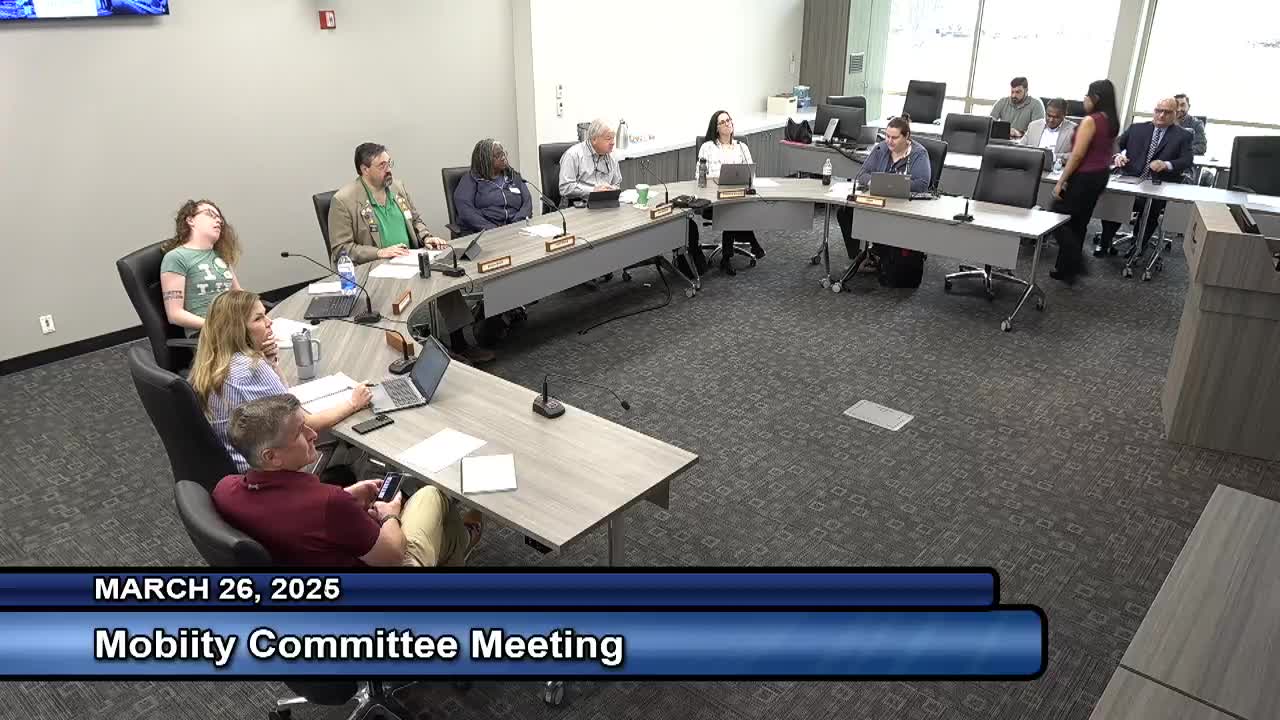Mobility committee reviews speed‑management/traffic‑calming plan emphasizing full‑bouts, bulb‑outs and tactical urbanism
March 26, 2025 | Denton City, Denton County, Texas
This article was created by AI summarizing key points discussed. AI makes mistakes, so for full details and context, please refer to the video of the full meeting. Please report any errors so we can fix them. Report an error »

Transportation staff presented a speed management and traffic calming action plan that prioritizes safety, low‑stress bike/ped facilities and quick‑build pilot projects.
Roy Scott, Transportation Services, said the approach put “human life over all road decisions,” and staff used a combination of a 2022 speed study, police input and engineers’ assessments to identify eight candidate corridors. The presentation highlighted three near‑term corridor concepts — the Boulevard corridor, Sycamore and Fry Street — and a toolbox of measures staff expects to use, such as full‑bouts, curb extensions (bulb‑outs), short medians and lane‑narrowing striping.
A short video presentation by Alexis Pickering explained full‑bouts: “Full bouts are an essential part of traffic calming,” she said, noting they reduce crossing distance for pedestrians and make pedestrians and bicyclists more visible to drivers. Committee members supported tactical urbanism pilots — temporary, low‑cost installations used to test solutions before permanent construction — and asked staff to prioritize community outreach so neighbors understand how a pilot will work and how success will be measured.
Committee members requested the data and metrics used to shortlist the corridors and asked staff to explain how Vision Zero (Vision 0) implementation planning will be coordinated with traffic calming work. Staff said traffic calming elements will be embedded in Vision 0 corridor selection and that a number of midterm opportunities—updates to the mobility plan and the transportation criteria manual—could formalize broader use of context‑sensitive street typologies.
Why it matters: the plan focuses on measurable, engineering‑based changes intended to reduce speeds, improve crossings and support walking and biking across multiple neighborhoods. Staff intends to run speed studies on the three pilot corridors to establish baselines and measure outcomes after implementation.
Roy Scott, Transportation Services, said the approach put “human life over all road decisions,” and staff used a combination of a 2022 speed study, police input and engineers’ assessments to identify eight candidate corridors. The presentation highlighted three near‑term corridor concepts — the Boulevard corridor, Sycamore and Fry Street — and a toolbox of measures staff expects to use, such as full‑bouts, curb extensions (bulb‑outs), short medians and lane‑narrowing striping.
A short video presentation by Alexis Pickering explained full‑bouts: “Full bouts are an essential part of traffic calming,” she said, noting they reduce crossing distance for pedestrians and make pedestrians and bicyclists more visible to drivers. Committee members supported tactical urbanism pilots — temporary, low‑cost installations used to test solutions before permanent construction — and asked staff to prioritize community outreach so neighbors understand how a pilot will work and how success will be measured.
Committee members requested the data and metrics used to shortlist the corridors and asked staff to explain how Vision Zero (Vision 0) implementation planning will be coordinated with traffic calming work. Staff said traffic calming elements will be embedded in Vision 0 corridor selection and that a number of midterm opportunities—updates to the mobility plan and the transportation criteria manual—could formalize broader use of context‑sensitive street typologies.
Why it matters: the plan focuses on measurable, engineering‑based changes intended to reduce speeds, improve crossings and support walking and biking across multiple neighborhoods. Staff intends to run speed studies on the three pilot corridors to establish baselines and measure outcomes after implementation.
View full meeting
This article is based on a recent meeting—watch the full video and explore the complete transcript for deeper insights into the discussion.
View full meeting
